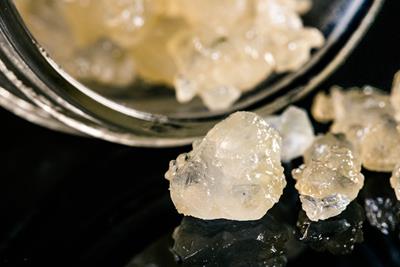
Sunday May 1, 2022
By Erin Hiatt
 Education
Education
You’ve heard it said that today’s weed is not your grandmother’s weed, and in some ways, the saying holds true. Prior to widespread legalization, consumers were frequently limited to low-quality illicit market marijuana, aka brick weed, and homemade pot brownies. Not so much anymore. Today’s consumers have practically as many options as there are strains.
One example of this is the explosion of cannabis concentrates. Market research and consulting firm, Grand View Research, estimates that the global cannabis extract market size will reach a value of $28.5 billion by 2027. As the name suggests, cannabis concentrates are concentrated cannabinoids, most often the high-inducing THC, and CBD, known for its anti-inflammation and analgesic effects.
To make a concentrate, the cannabis plant, specifically cannabinoid powerhouses called trichomes, are put through a solvent-based or solventless extraction process that separates cannabinoids like THC from other plant material to create a potent compound, sometimes as high as 98 percent.

But the cannabis plant is made up of more than 100 identified cannabinoids, aromatic compounds called terpenes, flavonoids, phenols, esters, and proteins. It has long been held that cannabis’ potential therapeutic benefits work better when the compounds of the plant stay together, a theory called the entourage effect. Most cannabis concentrates focus on one cannabinoid only – typically THC – leaving out the balancing effects of other compounds.
Some companies are working on putting other compounds back into concentrates, creating full spectrum concentrates. So what are they, and are they any better than their ultra-potent counterparts? Let’s dig in.
Full Spectrum Concentrates: What You Need to Know
Like we said, the cannabis plant has a whole lot going on: cannabinoids, terpenes, flavonoids, etc. A full spectrum concentrate is intended to capture each of these compounds while keeping unwanted components out. This is easier said than done. Some extraction methods can strip away more delicate compounds like flavonoids and terpenes. So, finding the extraction method that is “just right” is key to the creation of full spectrum concentrates.
Some believe that full-spectrum extraction is simply a healthier option because the chemical compounds of the plant are preserved instead of isolated. If one were to consume your basic THC concentrate, you will be in for a potent ride. Even though THC is most famously known for getting you high, research has shown some therapeutic benefits, including reducing pain, reduction of nausea from chemotherapy, modest improvement in muscle spasms in paraplegics, and improvement in sleep.

The same principle applies to CBD. In concentrate form, the reported benefits of CBD like nausea relief, and reduced anxiety, pain, and inflammation may be enhanced. A full spectrum CBD extraction will keep the plant’s other compounds intact, including trace amounts of THC.
But choose a full spectrum concentrate of either CBD or THC and you add in the potential therapeutic benefits of terpenes, which have shown – in vitro and in animal and clinical trials – to have antioxidant, analgesic, antidepressant, neuroprotective, and anti-inflammatory properties, among others. A full spectrum concentrate may also provide the benefits of flavonoids, phytonutrients that have shown anti-inflammatory effects and protect cells from oxidative damage that can lead to diabetes, cancer, and cognitive diseases.
The trick, however, is to know that what you’re consuming is actually full spectrum, which truth be told, is hard to do. There are few regulations in place to define what actually constitutes a full spectrum extract. The only way to really know is to read the label to ensure it has more than one compound. Some products to look out for that may actually be full spectrum (but again, read the label) are live resin, high-terpene full spectrum extract (HTFSE), and high-cannabinoid full spectrum extract (HCFSE).
Conclusion
So, are full spectrum concentrates better than that 80 percent live resin? As with any cannabis product, it really boils down to preference and your desired effect. If a potent high is the only item to check off, then that live resin will do just fine. If you are seeking a more balanced experience, check out the full spectrum.
Have you tried Full Spectrum concentrates? If so, let us know your experience in the comments!
Photo Credit: Shutterstock







